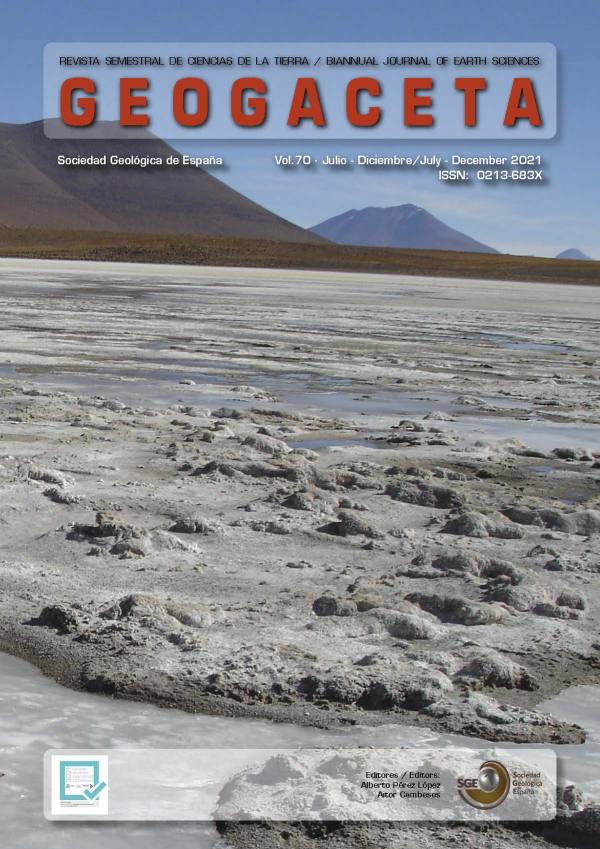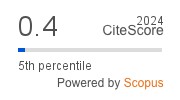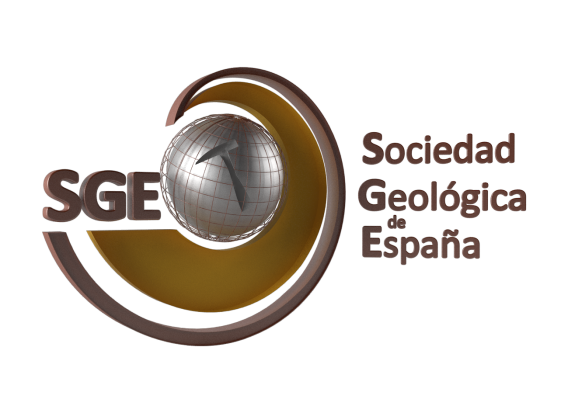Islas Cíes: una trampa eólica en la Ría de Vigo (Galicia, España) al final del último glaciar
DOI:
https://doi.org/10.55407/geogaceta102257Palabras clave:
eolianitas costeras, datación OSL, glacio-eustasia, Islas Cíes, Galicia (N.O. de España), Pleistoceno SuperiorResumen
Las Islas Cíes han constituido un obstáculo para los intensos vientos costeros del Atlántico Norte, especialmente durante las fases glaciares del Cuaternario. Al final del último glaciar el mar descendió más de 100 m por debajo de su nivel actual. Este descenso transformó el archipiélago en un relieve emergido de 300 m de alto, capaz de deflectar el viento y atraer, al mismo tiempo, sedimentos eólicos procedentes de una franja de plataforma continental también emergida. Bajo esta hipótesis, estos materiales eólicos se depositaron cubriendo el contorno de Cíes. Un ejemplo de estos episodios de acreción eólica es el afloramiento de eolianitas situado en la Isla de Monteagudo (Islas Cíes, Galicia, España), interpretado como una duna rampante que estuvo activa desde el final del Pleistoceno Superior, cubriendo parcialmente la vertiente oriental. Con un espesor de más de 3 metros y una edad (OSL) de 35 ka (b2k) en el muro y de 17 ka en el techo de la formación, este depósito es una prueba de la eolización desarrollada en la costa de Galicia durante miles de años, interrumpida al cesar los aportes durante el postglaciar holoceno.
Citas
Arce-Chamorro, C. (2017). Datación por luminiscencia de depósitos fluviales y eólicos en el margen occidental de Galicia. Tesis Doctoral, Univ. da Coruña, 399 p.
César-Vila, M. (2018). Memoria técnica ED 102A 2016/072-0. Xunta de Galicia, 177 p.
Costas, S., Muñoz-Sobrino, C., Alejo, I. y Pérez-Alurcea, M. (2009). Earth Surf. Process. Landforms. https://doi.org/10.1002/esp.1849
Costas, S., Jerez, S., Trigo, R.M.; Bogle, R., Rebêlo, L. (2012). Quaternary Science Reviews. https://doi.org/10.1016/j.quascirev.2012.03.008
EDMOnet Bathymetry (2018) https://www.emodnet-bathymetry.eu/.
Greeley, R. e Iversen, J.D. (1985). Wind as a Geological Process on Earth, Mars, Venus and Titan. Cambridge University Press. Cambridge, 333 p. https://doi.org/10.1017/CBO9780511573071
Gutiérrez-Becker, L. (2008). Caracterización de los sistemas dunares costeros del NW ibérico y su evolución durante el Cuaternario. Tesis Doctoral, Univ. da Coruña. 283 p.
Krumbrein, W.C. y Sloss, L.L. (1963). Stratigraphy and Sedimentation. W.H. Freeman and Co., San Francisco, 660 p.
López-Romero, E., Bóveda-Fernández, M.J., Güimil-Fariña, A., Mañana-Borrazás, P., Sanjurjo-Sánchez, J., Vázquez-Collazo, S., Vilaseco-Vázquez, X.I. (2020). En: I International webinar. IRN PrehCOAST - French Prehistoric Society. Communications 1, 15.
Murray, A.S. y Wintle, A.G. (2000). Radiation Measurements. https://doi.org/10.1016/S1350-4487(99)00253-X
Mohamed, K.J., Rey, D., Rubio, B., Vilas, F., Frederichs, Th. (2010). Quaternary Research. https://doi.org/10.1016/j.yqres.2010.02.003
Nombela, M.A., Alejo, I., Bernárdez, F., Clemente, F., Costas, S., Diz, P., Fernández-Bastero, S., Francés, G., Gago-Duport, L., García, T., González-Alonso, D., González-Álvarez, R., González-Villanueva, R., Liquete, C., Pena, L.D., Pérez-Alurcea, M. (2005). En: Coastal Hope Conference Proceedings 1, 99-100.
Pye, K. y Tsoar, H. (1990). Aeolian sand and sand dunes. Unwin Hyman Ltd., London, 400 p.
Rey-Salgado, J. (1993). Instituto Español de Oceanografía 17, 233p.
Rodríguez-Fernández, R. (2013) Guía Geológica del Parque Nacional de las Islas Atlánticas de Galicia. IGME. 202 p.
Trinidade, M.J., Prudêncio, M.I., Sanjurjo-Sánchez, J., Vidal-Romaní, J.R., Ferraz, T., Fernández-Mosquera, D., Dias, M.I. (2013). Geológica Acta, https://doi.org/10.1344/105.000001838.
Vidal-Romaní, J.R., Fernández-Mosquera, D., Marti, K., De Brum-Ferreira, A. (1999). Cuadernos do Laboratorio Xeolóxico de Laxe 24, 7-29.
Vidal-Romaní, J.R., Fernández-Mosquera, D., Marti, K. (2015). Cadernos do Laboratorio Xeolóxico de Laxe 38, 25-44. https://doi.org/10.17979/cadlaxe.2015.38.0.3681
Vidal-Romaní, J.R. y Grandal-d'Anglade, A. (2018). Cadernos del Laboratorio Xeolóxico de Laxe. https://doi.org/10.17979/cadlaxe.2018.40.0.4921
Waelbroeck, C., Labeyrie, L., Michel, E., Duplessy, J.C., McManus, J., Lambeck, K., Balbon, E. y Labracherie, M. (2002). Quaternary Science Reviews. https://doi.org/10.1016/S0277-3791(01)00101-9
Wentworth, C.K. (1922). Journal of Geology 30, 377-392. https://doi.org/10.1086/622910
Descargas
Publicado
Cómo citar
Número
Sección
Licencia

Esta obra está bajo una licencia internacional Creative Commons Atribución-NoComercial-CompartirIgual 4.0.
Hasta el año 2023 el autor/a cedía el copyright (“derechos de autor”) a la Sociedad Geológica de España, pero desde el 2024 el/la autor/a conserva los derechos de autor y concede a la Sociedad Geológica de España el derecho de la primera publicación y de manera no exclusiva cede la distribución de cada artículo en todos los soportes actuales o futuros, al mismo tiempo que ceden, también de manera no exclusiva, los derechos comerciales para la distribución de la versión impresa de Geogaceta. Por otra parte, los artículos, a partir del año 2023, están disponibles simultáneamente a su publicación, bajo la licencia Creative Commons CC BY-NC-SA 4.0, que permite copiar, transformar el trabajo, pero si se distribuye transformándolo, el nuevo trabajo debe distribuirse bajo la misma licencia, y nunca con propósitos comerciales, al tiempo que se reconoce la autoría y la publicación original en GEOGACETA, de tal manera que el único rol del copyright es dar a los autores el control sobre la integridad de sus trabajos y el derecho de ser adecuadamente reconocidos y citados.









